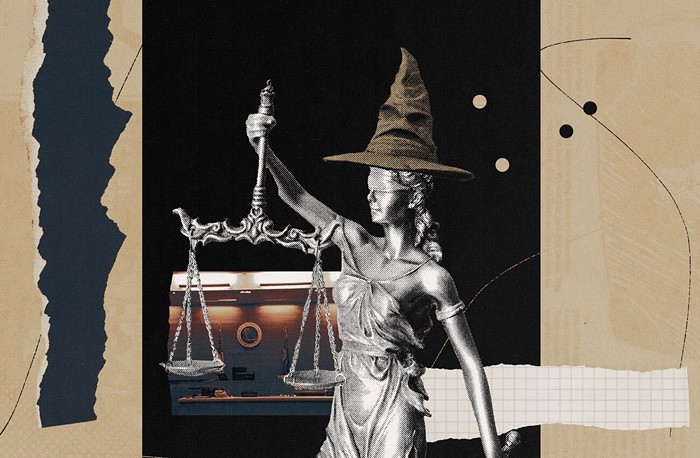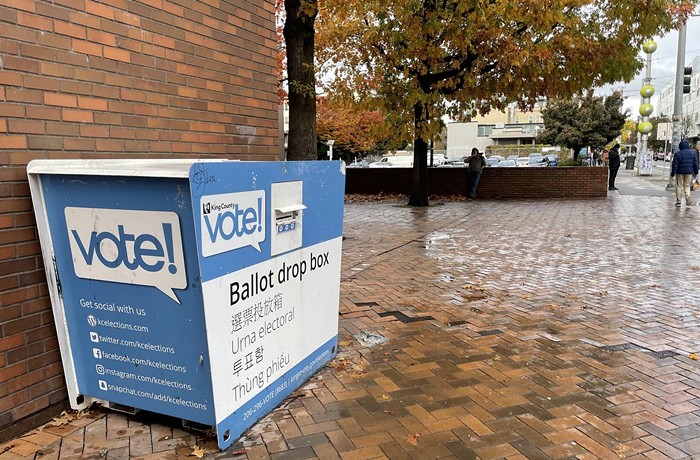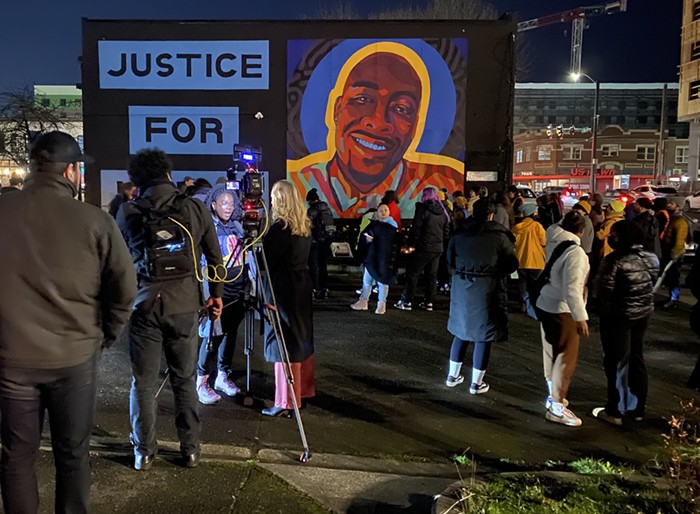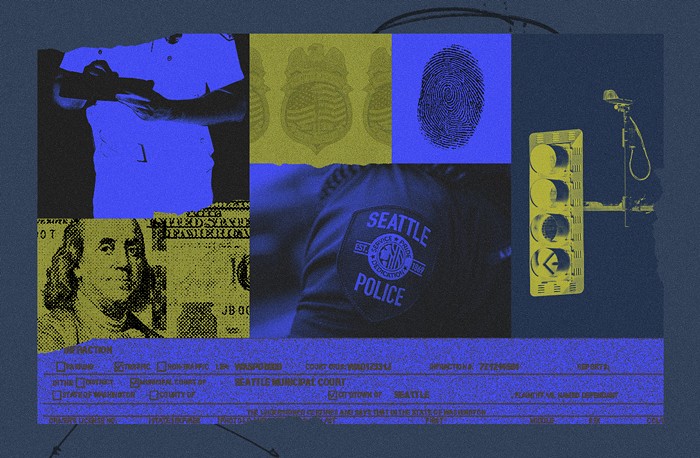And so, what with the state of the world and the state of art, we thought that now was a good time to write up a few of the things we like. It may seem like war is all there is to think about or write about lately, but there's more going on in Seattle than just demonstrations and handwringing. And while the war news may be all bad, all the time, it turns out there's a lot to be excited about: people, events, movements, new philosophies. In theater and art and music and books and even the notoriously cynical and overbudgeted film world, life goes on. Much of it, as you'll see, happens outside the bland, government-sanctioned definition of what art is (and what should be paid for), as well as outside Seattle's heavy-hitting arts organizations--outside the usual places in the hands of the usual suspects.
Here, then, is our paean to the (mostly) small, the weird, the marginal, the happening--a few reasons to live, to get out of the house, away from the television. Art isn't about escapism--but it is an alternative to despair. EMILY HALL
Herbert West: Re-Animator
Open Circle, April 4-25
Zombies. There just aren't enough of them on stage these days. Few things are as potentially entertaining as a headless corpse (or corpseless head) skulking putridly from its grave to drop steaming clods of itself all over the place and angrily gnaw the faces from hapless village folk. It's a venerable, universal theme, and a potential goldmine of quality theatrical fodder that has remained largely ignored.
Visionary local fringe director Matt Fontaine understands this. To remedy the situation, he brought the gruesomely gruesome Herbert West: Re-Animator to Fringe Fest 2002. The zombie-rich tale of murderous geniuses with serious messiah complexes doing what they do best (fucking around with Mother Nature and provoking Her terrible wrath) was a huge hit.
The story--based on the H. P. Lovecraft serial of the same name and adapted for the stage by Zack Lenihan--is classic: Young, borderline-insane idealist hooks up with young, fully insane idealist, and terror ensues. The diabolical idealists inject the recently dead with an eerie fluorescent-green serum, then act really surprised when the dead arise and get pissed. (What were they expecting, a fruit basket?) When they run out of fresh corpses, they start improvising with healthy locals. (Science can't just sit around waiting, you know.) Driven by their lust for knowledge--ergo, power--the men travel from town to town, leaving a trail of twice-baked corpses in their wake. Fabulous.
Open Circle Theater has revived this new fringe theater cult hit, adding a few more flourishes, a feverish new original score by Ian Rashkin, and a few new cast members, but has assured us that all of the "shock, schlock, and drawing-room class of the original" will be present and accounted for. Creepy graveyards, flesh-eating ghouls, spooky blue lighting, a vaguely homoerotic subplot, needle drugs, and live music: What's not to love? ADRIAN RYAN
In Flagrante Gothicto
Empty Space, June 19--July 20
After establishing themselves as stars on the Seattle fringe theater scene, Alice Dodd (a beloved Annex Theatre alumna) and Jillian Armenante (a worship-worthy mainstay of Annex, Alice B. Theatre, and Empty Space) moved to Los Angeles in 1997. Hot on the heels of Armenante's acclaimed turn in the smash stage adaptation of John Irving's Cider House Rules (which she followed from Seattle to Los Angeles to New York City), the actress landed a recurring role on the CBS nighttime drama Judging Amy. But something was missing.
"We wanted to do a play," says Armenante, "but we couldn't find one we liked." Armenante and Dodd were craving a "big, theatrical, gothic-ish play," but their search for an existing script proved fruitless, and so they set about writing a script of their own.
The result was In Flagrante Gothicto, a brainy, campy spoof of the gothic genre drawing primarily from the Holy Trinity of gothic literature--Jane Eyre, Wuthering Heights, and Rebecca. The play, written over the course of two weeks, was given a "British-sounding" male author for its initial reading. But when response to the script was uniformly enthusiastic, Armenante and Dodd got over their shyness and set about staging their debut play.
Produced by Los Angeles' Circle X Theatre in 2000, In Flagrante Gothicto's debut could hardly have received a more passionate reception. The Los Angeles Drama Critics Circle gave the show awards for writing, directing, and production, along with the Ted Schmitt Award for "Most Outstanding Debut of a New Play."
This June, Empty Space will produce the Northwest premiere of In Flagrante Gothicto, directed by Armenante and Dodd's former Annex crony (and current Empty Space artistic director) Allison Narver. It should be a match made in heaven, cultivated right here in Seattle. DAVID SCHMADER
21 Dog Years: Doing Time at Amazon.com
Intiman, fall 2003
Mike Daisey is coming back to Seattle--to Intiman, no less! (Nothing like impending financial ruin to cultivate Big Theater's interest in money-saving one-man shows.) This October, the solo performer and author will return with 21 Dog Years, his smart and hilarious vivisection of the boom years at Amazon, and dot-com cult(ure) as a whole. After his initial Seattle run at the humble Speakeasy Cafe, Daisey took his show to New York, where it met with enthusiastic reviews from no less than the New York Times.
In 21 Dog Years, Daisey attacks the arrogant ethos of our now-deflated economy.com with sharp wit and blunt scorn.
His story, however, is bigger than late-20th-century Seattle. Daisey's examination of tech-boom hysteria, the overoptimistic insanity of will without substance, has eerie resonance with a contemporary America perched on what may be a serious crash of its political stock options.
Sadly, Daisey's eastward relocation lends credence to the local joke that actors need to move to New York or L.A. to "make it" in Seattle. Welcome back, Mike. BRENDAN KILEY
Impassio Press
"Impassio," a made-up word that at once suggests "impossible," "passion," and "impassioned," was invented by Olivia Dresher to designate the Seattle-based press she established in 2001. Its program is to publish "a variety of fragmentary writing... journals, diaries, and notebooks." Dresher believes that these scraps, half-thoughts, and lost-and-found notes form "a valid literary art form (as valid as the established, accepted forms of novels, short stories, poetry, etc.)."
Impassio Press published its first three journal-based books last year--One Journal's Life by Audrey Borenstein; This Is How I Speak by Sandi Sonnenfeld; and Water & Earth by Guy Gauthier--and in June is to publish a book called Traveling Light, about photographer Deborah DeWit Marchant's impossible search for different qualities of light. Though regional, Impassio is looking for and accepting work from all over the world, as long as it reflects the press' primary aesthetic: impressions, flickers, that which arises suddenly and briefly from the beautiful haze of memory and being. "I'm very interested in form, forms that fall through the cracks," says Dresher over the phone. "I want to publish stuff that is part memoir, part poetry, part novel. To publish forms that can't easily be explained. It's a unique press in that way. I don't think there is another press that does what Impassio does: focuses on fragmentary writing." CHARLES MUDEDE
Alex Schweder's Peeple
Available at Howard House, 2017 Second Ave, 256-6399, $140
A couple of years ago, Alex Schweder's Peescapes--a series of customized urinals--focused our attention on an act we'd rather not think too closely about. His philosophical inquiry into urine continues with Peeple, a thick, yellow, toddler-style board book containing images of his conceptual urinal games--in this case, paper-doll figures you put in your urinal and pee on until their clothes magically disappear.
I wonder if this is a reference to the alchemy of the body, the magical transformation of water into urine. In any case, the urinal games are still more or less a pipe dream (the technology, I am given to understand, that would allow urine to dissolve a single layer of ink doesn't yet exist), but Peeple allows us to fantasize. We've all accepted that a penis is a bayonet, a rifle, a cigar; why not give it supernatural powers as well? EMILY HALL
Experimental Theology
Seattle Research Institute, out in May 2003
www.seattlersearchinstitute.org
Most religious texts are historically based, stoic, severe, dogmatic, and polarizing, but the contributors to Experimental Theology indulge in more experimental approaches. There is a decided interest, in periphery. Almost all of the work deals with the sensual trappings of religion: the human forms, the formal rites, the costumes, the luscious food, the sexuality, the opulence. Irreverence (read: impoliteness) seems to be one of the primary guiding principles under which this project was conceived, and these writers go to great lengths to entertain and expose all the aspects of their beliefs that are personal, perplexing, and perverted. In distorted and abstract ways, the work gathered here--by such enlightened luminaries as Rebecca Brown, Nico Vassilakis, Diana George, and Steven Shaviro--struggle toward coherence, comprehension, and conciliation; but these are not scholarly arguments, they are aesthetic ruminations. This is not a hard and fast guide for anyone struggling to understand theology, or believe in it--because, as these writers make evident, they don't understand or necessarily believe in it themselves. CHRISTOPHER FRIZZELLE
Austin Plann Curley and Beware of the Walls
I knew about Austin Plann Curley before I discovered him. What I mean is that I had looked at his work--which consists most publicly of stenciled images spray-painted onto building walls and newspaper boxes and highway underpasses--before I ever really saw it. The distinction between seeing and looking is important here; these are the kinds of works that occupy a hole in your peripheral vision, or else they become part of the landscape that has become invisible with familiarity, until you see them.
Maybe you already know some of Plann Curley's stencils: the genial fragmented face of Sister Wendy, or the dapper, faceless man, or the little stick figure preparing to jump off a newspaper box. At one Seattle intersection, he created a lone parking space, catawampus and illogical, complete with yellow street turtles and the stenciled legend "angle parking only." Some of his projects, like the latter, are a surreal rearrangement of the everyday; others, like the crescent of dead grass he made in Volunteer Park last fall--by placing "Parks and Recreation" signs over patches of grass until they died--slyly point out how blindly we accept authority, as if, in fact, we don't even notice it.
Look around for works by his new stencil gang, Beware of the Walls. He's also thrilled by inadvertent collaboration, as with whoever it was who went around drawing faces on his faceless men. This is urban art: fueled by banal interaction, raised to a philosophical level. EMILY HALL
Western Bridge
Bill and Ruth True have been, for the last few years, quietly amassing one of the best art collections in Seattle. You may not have heard of them--they're not as visible as some other local collectors, but you only have to penetrate about an inch into the art world to start hearing their names everywhere, largely because they avidly collect work in new media (which is notoriously difficult to show in your own home) and love living with it. Their pleasure in their own collection, from the Gary Hill in the living room to the Dan Flavin in the stairwell, is palpable.
This fall, the Trues are opening a 10,000-square-foot exhibition space, designed by Roy McMakin's firm Domestic Architecture, in SoDo. This new space, which will have a strong emphasis on new commissions and residencies, will be called Western Bridge. It's a found name--the name of the company that built the industrial property the gallery will occupy--but it also has an allusive appropriateness to it. According to Eric Fredericksen, Western Bridge's gallery director and a former Stranger writer, "It also suggests a means to an end, not just exhibition space but something that will support projects and be an active place, a bridge between the local art world and the national and international art worlds."
Western Bridge's first show, which will probably open in October, will exhibit the Trues' own collection, plus a new commission. Mark my words: This is one of the best things to happen around here in a while. EMILY HALL
Thread
The art world, I am sorry to say, is not a particularly generous place. There is just not enough fame, money, or attention for everyone, and as a consequence, people tend to hoard their discoveries, to keep their connections to themselves.
Thread--cofounded by graphic designer Rebecca Richards and former Henry curator Rhonda Howard--works directly against this tendency. The very name suggests connections between people and resources and ideas; the point is to create opportunities for artists, to raise money for exhibitions (both Thread-organized and artist-organized) and books about artists' work, and to share the kinds of information and skills that make such things possible.
Thread made its first public appearance with the publication of LAVA 2002, a lavish catalog for last year's Noodleworks Invitational, a show of work by mostly unrepresented artists. Next month, Thread will publish a gorgeous book about artist Robert Yoder; in the works is a project about fashion as art that started when artists Yuki Nakamura and Claudia Fitch came to Howard and told her they wanted to do a fashion show. It has since expanded to include an ongoing display of fashion/art objects in store windows around the city, and an accompanying publication.
Howard and Richards have organized Thread in two parts: the profit part--which includes design and certain art-advisory services, and will eventually feature artist-made and artist-designed objects--funds the nonprofit part, which is about exhibition and publication and various artist services. What is particularly exciting about Thread is its looseness: Howard, in particular, after years of shoehorning artists and their work into the institutional framework favored by museums, is determined to let artists' practices and ideas shape her projects, rather than the other way around. EMILY HALL
The Milkbar
Various locations; http://milkbar.prispop.com
The Milkbar is more of an idea than a location, but cofounders Burke Thomas and Ian Templeton aren't trying to do what every other club in Seattle does. They're comfortable doing their own thing--which is, according to Thomas (who is also the frontman of the local pop rock band Pris), "to provide an outlet for new bands to be seen and heard without as much of a club-clique mentality." In a city swarming with people who often take themselves too seriously, the boys at the Milkbar just want to have a good time.
"Most clubs book by genre. This makes sense financially for the club and the bands, but we're not very logical," says Thomas.
"We're building a reputation for variety," Templeton adds, "so we're able to get away with a lot."
Things they're going to try to get away with in the future include adding more visual art to the Milkbar experience.
"We'd especially like to incorporate more film and large installations--not so much ceramics, ice sculpting, or mimes, though," says Thomas.
"I really want to see more theme nights, too," adds Templeton. "Like battle-of-the-bands shows involving assorted weapons!"
"Yeah, our battle-of-the-bands kickoff show will have two stages facing each other, with the crowd standing in between," says Thomas. "One band will play a couple tunes as the crowd and the other band pelts them with small Nerf basketballs in order to distract them from their rocking. Then, it's the other band's turn. You get the idea. It's called 'fun.'"
And that's why I love the Milkbar. MEGAN SELING
Sun Tzu Sound
The Baltic Room
Sun Tzu Sound--a collective of DJs, producers, and promoters--has cooperatively taken inspiration from the ancient text The Art of War by Sun Tzu and applied those philosophies to combating dull approaches to Northwest electronic music.
The collective (which includes locals AC Lewis, Atlee, J-Justice, Mikey, and Vancouver-based Dr. J.) has in a short time put together some excellent shows, bringing in international broken beat, future jazz, downtempo, and new-school funk and soul artists who probably otherwise wouldn't have given Seattle a second thought: London broken beat pioneers Bugz in the Attic, Afronaught and Seiji, as well as the Berlin future jazz authorities in Jazzanova. Sun Tzu has been using two weekly parties at the Baltic Room (Thursday's House Guest and Sunday's Beat-Bop) as primary vehicles for its productions. "Overall it's going to be eclectic," explains J-Justice. "You're not going to get the same house records that you hear every week. For House Guest, we're trying to get the house freaks out in order to expose them to some new stuff." AC Lewis adds, "Beat-Bop is much more adventurous, with more broken beat and future jazz. We can pretty much do whatever we want."
So if you're looking for some solid grooves with future curve sensibilities, pay close attention young grasshopper. NICOLAE WHITE
Meme Concert Series
Next event April 11; see the events calendar at www.cocaseattle.org for info
Pretentious? Sure. A little pointy-headed? Probably. But for the past eight months the Meme Concert Series, under the direction of curator Sam Mickens, has delivered one of the most compelling upstarts in the city.
Meme offers a reliable alternative to the stagnant club scene, a venue for accessibly experimental pursuits. CoCA is perhaps the palest excuse for a rock club there has ever been: Absent are the loathsome stage lights, filthy piss-stained bathrooms, throat-wrenching smoke, and inevitable beer-spilling assholes that music fans have grown to find so endearing. What remains is a modest sound system and an affably intimate ambiance--a perfect venue for Meme's uncompromising, artistically relevant performances.
Taking the name from a term coined by biologist Richard Dawkins (a meme is an information pattern that infects human minds and alters behavior), the barely legal Mickens began the not-for-profit series in late August of last year, with a vision for a cerebral blend of fringe pop music and the deliberately experimental. The months that followed witnessed sets by such art-school notables as Bill Horist, Mecca Normal, Sharon Cheslow, Xiu Xiu, Michael White, Casiotone for the Painfully Alone, Switch, Das Yellow Swans, the Nels Cline Singers, Display, dk pan, Bobby Karate, and the Intima. Hints of the future suggest more artistically secular events, some exciting upcoming performances, and even the possibility of a live compilation record. "The city's options for experimental music performance--though in many cases really incredible--are generally of fairly narrow focus," reflects Mickens. "And I guess I was just looking to create an event that was more distinctly integrated." ZAC PENNINGTON
No Extra Day
To be honest, I know very little about the quality of the film No Extra Day. What I do know is this: It's a low-budget (under $20,000) comedy, locally made, about the closing of a beloved video store. Its creators are two chaps named Michael Fitts (director) and Brandon Dodds (producer), and they are currently in the midst of postproduction hell.
I haven't seen the film, nor have I read about it anywhere outside of the production's own website, but the idea of the movie is a beautiful thing indeed: Even in this frigid economic climate, people here in Seattle (and elsewhere) still pursue that seemingly impossible dream of filmmaking.
I first encountered No Extra Day over a year ago, when I stumbled across the aforementioned website. Detailing the film's now-epic production (casting began in November of 1998), the site breaks down the creation--from inception to the current sound-synching blundering--in diary form, and I've been checking in on it at least once a month ever since. I've been with Fitts and Dodds (and their cast and crew) through much of their travail--including the time their film was seized by an editing house.
Think about it: 1998-2003. Five years struggling on a $20,000 production, with no real guarantee that the final product would ever appear before an audience. The website, www.noextraday.com, should be required reading for any hopeful first-time filmmaker.
Mucho Mucho Theaters and Festivals
Us city dwellers undoubtedly take for granted the amount of quality and/or experimental and/or foreign/independent/weird/obscure film venues we have here in Seattle. A quick list of those within the city limits: the Seven Gables chain, the Grand Illusion, the Little Theatre, the Big Picture, the Rendezvous, Consolidated Works, 911 Media Arts Center, and the JBL Theater at EMP. And the many festivals often shown at said venues: Seattle International Film Fest, Women in Cinema, Jewish Film Fest, Irish Film Fest, Polish Film Fest, Lesbian & Gay Film Fest, Seattle Underground Fest, Asian Film Fest, Fremont Outdoor Cinema, Satellites, New Dance Cinema, and One Reel at Bumbershoot. Not to mention the various digital film fests, documentary fests, Super-8 fests, and venues (like Linda's and the Sunset Tavern) that show weird/entertaining shit whilst plying you with booze.
What does this all add up to? A city brimming with le cinéma--and one that, when you consider the size of Seattle (as opposed to New York or San Francisco), quite possibly may have more than its share of film. It's worth taking a minute to remember this. BRADLEY STEINBACHER


















